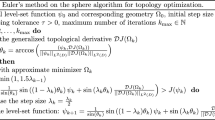Abstract
In this paper we consider a mathematical model for magmatic mixtures based on the Gibbs free energy. Different reformulations of the problem are presented and some theoretical results about the existence and number of solutions are derived. Finally, two homotopy methods and a global optimization one are introduced and computationally tested. One of the homotopy methods returns a single solution of the problem, while the other is able to return multiple solutions (often all of them). The global optimization method is a branch-and-reduce one with a theoretical guarantee of detecting all the solutions, although some numerical difficulties, resulting in a loss of a few of them, may have to be faced.






Similar content being viewed by others
References
Allgower, E.L., Georg, K.: Introduction to Numerical Continuation Methods. SIAM, Philadelphia (2003)
Anderson, G.M., Crerar, D.A.: Thermodynamics in Geochemistry. The Equilibrium Model. Oxford University Press, Oxford (1993)
Asimow, P.D., Ghiorso, M.S.: Algorithmic modifications extending MELTS to calculate subsolidus phase relations. Am. Mineral. 83, 1127–1131 (1998)
Belotti, P.: Couenne: a user’s manual. Technical report, Technical report, Lehigh University (2009)
Best, M.G., Christiansen, E.H.: Igneous Petrology. Wiley/Blackwell, New York (2001)
Boudreau, A.E.: PELE–a version of the MELTS software program for the PC platform. Comput. Geosci. 25(2), 201–203 (1999)
Brouwer, L.E.J.: Über Abbildung von Mannigfaltigkeiten. Math. Ann. 71, 97–115 (1912)
Dantzig, G., Johnson, S., White, W.: A linear programming approach to the chemical equilibrium problem. Manag. Sci. 5(1), 38–43 (1958)
Dobran, F., Ramos, J.I.: Global volcanic simulation: physical modeling, numerics, and computer implementation. In: Dobran, F. (ed.) Vesuvius—Education, Security and Prosperity. Developments in Volcanology, vol. 8, pp. 311–372. Elsevier, Amsterdam (2006)
Fabrichnaya, O., Saxena, S.K., Richet, P., Westrum, E.F.: Thermodynamic Data, Models and Phase. Springer, Berlin (2004)
Fletcher, R.L.: Practical methods of optimization, 2nd edn. Wiley, New York (2000)
Floudas, C.A., Akrotiriankis, I.G., Caratzoulas, S., Meyer, C.A., Kallrath, J.: Global optimization in the 21st century: advances and challenges. Comput.-Aided Chem. Eng. 18, 23–51 (2004)
Mark, Ghiorso, S., Hirschmann, M.M., Reiners, P.W., Kress, V.C. III: The pMELTS: an revision of MELTS aimed at improving calculation of phase relations and major element partitioning involved in partial melting of the mantle at pressures up to 3 GPa. Geochem. Geophys. Geosyst. 3(5) (2002)
Ghiorso, M.S.: Algorithms for the estimation of phase stability in heterogeneous thermodynamic systems. Geochim. Cosmochim. Acta 58(24), 5489–5502 (1994)
Ghiorso, M.S., Sack, R.O.: Chemical mass transfer in magmatic processes IV. A revised and internally consistent thermodynamic model for the interpolation and extrapolation of liquid-solid equilibria in magmatic systems at elevated temperatures and pressures. Contrib. Mineral. Petrol. 119, 197–212 (1995)
Gill, P.E., Murray, W., Saunders, M.A.: User’s guide for SNOPT version 7: software for large-scale nonlinear programming (2007)
Jalali, F., Seader, J.D.: Homotopy continuation method in multi-phase multi-reaction equilibrium systems. Comput. Chem. Eng. 23(9), 1319–1331 (1999)
Karpov, I.K., Chudnenko, K.V., Kulik, D.A., Bychinskii, V.A.: The convex programming minimization of five thermodynamic potentials other than Gibbs energy in geochemical modeling. Am. J. Sci. 302(4), 281 (2002)
Marzocchi, W., Sandri, L., Selva, J.: BET_EF: a probabilistic tool for long- and short-term eruption forecasting. Bull. Volcanol. 70, 623–632 (2008)
Mawhin, J.: Leray-Schauder continuation theorems in the absence of a priori bounds. Topol. Methods Nonlinear Anal., J. J. Schauder Center 9, 179–200 (1997)
Moretti, R., Papale, P.: On the oxidation state and volatile behavior in multicomponent gas-melt equilibria. Chem. Geol. 213(1–3), 265–280 (2004). 7th Silicate Melt Workshop
Papale, P., Moretti, R., Barbato, D.: The compositional dependence of the saturation surface of H2O+CO2 fluids in silicate melts. Chem. Geol. 229(1–3), 78–95 (2006)
Rote, G.: The convergence rate of the sandwich algorithm for approximating convex functions. Computing 48, 337–361 (1992)
Sahinidis, N.V.: In: BARON Branch And Reduce Optimization Navigator. University of Illinois at Urbana-Champaign Department of Chemical Engineering, 600 South Mathews Avenue, Urbana, Illinois 61801, USA, 0.4 edn., June (2000)
Sigurdsson, H.: Encyclopedia of Volcanoes. Academic Press, San Diego (1999)
Smith, P.M., Asimow, P.D.: Adiabat _1ph: A new public front-end to the melts, pmelts, and phmelts models. Geochem. Geophys. Geosyst. 6(1) (2005)
Smith, W.R., Missen, R.W.: Chemical reaction equilibrium analysis: theory and algorithms. Krieger, Melbourne (1991)
Sparks, R.S.J.: Forecasting volcanic eruptions. Earth Planet. Sci. Lett. 210(1–2), 1–15 (2003)
Srinivas, M., Rangaiah, G.P.: A study of differential evolution and tabu search for benchmark, phase equilibrium and phase stability problems. Comput. Chem. Eng. 31(7), 760–772 (2007)
Sun, A.C., Seider, W.D.: Homotopy-continuation method for stability analysis in the global minimization of the Gibbs free energy. Fluid Phase Equilib. 103(2), 213–249 (1995)
Tawarmalani, M., Sahinidis, N.V.: Global optimization of mixed-integer nonlinear programs: a theoretical and computational study. Math. Program. 99(3), 563–591 (2004)
Tawarmalani, M., Sahinidis, N.V.: A polyhedral branch-and-cut approach to global optimization. Math. Program. 103, 225–249 (2005)
Textor, C., Graf, H., Longo, A., Neri, A., Ongaro, T.E., Papale, P., Timmreck, C., Ernst, G.G.J.: Numerical simulation of explosive volcanic eruptions from the conduit flow to global atmospheric scales. Ann. Geophys. 48(4–5) (2009)
Van Zeggeren, F., Storey, S.H.: The Computation of Chemical Equilibria. Cambridge the University press, Cambridge (1970)
Author information
Authors and Affiliations
Corresponding author
Rights and permissions
About this article
Cite this article
Cassioli, A., Consolini, L., Locatelli, M. et al. Optimization and homotopy methods for the Gibbs free energy of simple magmatic mixtures. Comput Optim Appl 55, 427–457 (2013). https://doi.org/10.1007/s10589-013-9532-0
Received:
Published:
Issue Date:
DOI: https://doi.org/10.1007/s10589-013-9532-0




